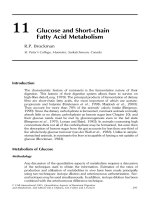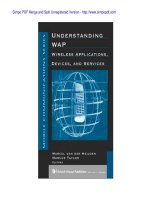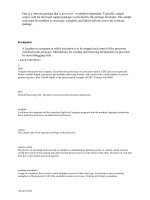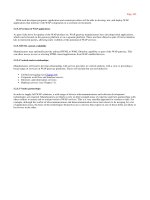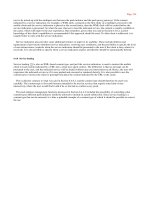Understanding WAP Wireless Applications, Devices, and Services phần 9 pptx
Bạn đang xem bản rút gọn của tài liệu. Xem và tải ngay bản đầy đủ của tài liệu tại đây (527.76 KB, 24 trang )
Page 227
Figure 10.12 Typical stovepipe solution to multichannel support.
Figure 10.13 A shared business object: multichannel delivery architecture.
Page 228
which may or may not be proprietary. Equally important, each of the subchannels has different operational characteristics
(e.g., the back channel of iTV may be permanently open or not), which needs to be taken into consideration when
designing applications.
A similar situation exists with the mobile channel. As we have already seen, we are faced with the prospect of dealing
with SMS and USSD messages, voice or DTMF
-based IVRs, SIM toolkit, WAP, PDAs, and laptops. While there is a
good chance that WAP will become the dominant technology for mobile devices, it will be several years before it is
ubiquitous in the installed base of mobile phones. In the meantime, we are faced with a heterogeneous and fairly diverse
environment. It is therefore probable that the mobile commerce provider will have to be content with at least two of the
above technologies.
In this world, with many subchannels to support, it is desirable to eliminate as much as possible the business
functionality from the channel-specific parts of system. In the current model, the generation of the presentation layer
from the underlying business objects is done on a channel-by-channel basis. While this code is not extensive in a thin-
client environment, there is nevertheless duplication and replication of logic. For larger, new developments it will
probably be worthwhile to introduce another tier in the architecture. Figure 10.14 shows a new channel-neutral
presentation layer.
In this case, rather than trying to postprocess the Web interface into other formats, all the channels derive their
presentation layers from a new channel neutral format (CNF). In this model, a single logical process constructs the CNF
for all channels. This is then parsed and rendered for each (sub)channel. In this way the channel-specific code becomes
more stable and does not need to be changed when the application is enhanced or new application features are added. An
increasingly popular approach to this is to use XML for the CNF. This XML-based intermediary presentation definition
has several advantages.
l
Web browsers are evolving to be able to render XML directly by using cascading style sheets (CSS) and
extensible stylesheet language (XSL).
l
WML is available as an XML document type definition (DTD).
l
Parsers and other XML-based tools are now readily available in sev-eral languages (Java, C++, and Visual Basic).
TEAMFLY
Team-Fly
®
Page 229
Figure 10.14 A next generation multichannel delivery platform.
l
XML is becoming the language of e-commerce, with existing standards such as OFX migrating to be XML
compliant.
l
XML is easily extensible, so addition tags can be added such as MIN|MAX values or mandatory indicators on
requested data fields. In this case care must be taken when parsing the XML, so that unexpected new tags are
properly handled.
10.14 Building financial WAP applications
Over and above the considerations for building WAP applications, there are several factors which must be considered
when designing and constructing mobile financial services (FS) applications.
It is likely that early FS applications will target mobile business people (as described in the introduction to this
chapter) and high net-worth customers. These are exactly the same people who will adopt other value-added services
targeted at them. It is important therefore that any new FS application should at least coexist with, and preferably
Page 230
cooperate with, these other services. The most important of these is unified messaging.
With unified messaging it is possible to mix and match message creation, notification, and delivery to the most
appropriate device at the time. In this new world users can be notified on a mobile phone of the arrival of e-mail in their
universal or corporate inbox from a VIP sender. They can then opt to be sent a synopsis, forward it to a colleague, or
send a copy of the text to a local fax machine. They can even elect to have their e-mail read to them, and choose to
dictate a reply into an IVR-enabled message center.
The wireless network providers are embracing this goal by designing “intelligent networks.” With a single number for
all of my calls, land and wireless, the network can be told when I am working, traveling on business, or enjoying leisure
time, and respond accordingly.
Sophisticated mobile users will soon expect that all mobile commerce applications will work in a compatible way to
their most used value-added service: messaging. As an example, I should be able to buy shares using my WAP phone,
hold the contract note as a message, and print it once I have access to a suitable device.
This mobile executive can also expect to start to see a convergence of accessories. At present it is possible to purchase
mobile phones with calculator and clock functionality. With the emergence of electronic cash technologies, the
traditional wallet will start to disappear. The combination of wireless and smart cards will provide an easy to use and safe
method for creating and storing encryption keys and other sensitive information. Finally, WAP-based applications will
reduce the need to carry a PDA or organizer.
If we now look at the main issues facing the mobile commerce developer, we can build on the points already covered.
As we have said, it is good practice not to ask a user to enter data already known about that customer by the financial
services organization. This is particularly true for the WAP phone, as data entry via a keypad will be slow. It is also
likely that the user will be on the move and access to personal data such as share portfolios will be limited. Therefore,
data entry should be minimized using the following techniques.
l
Personalization based on the customer profile or previous usage of the application can limit the navigation
required by presenting menus in an optimized order.
Page 231
l
Default values for data fields should be offered where possible.
l
Using an associated Web site, it should be possible to create lists, which can then be accessed via the WAP phone
(e.g., shares to track).
Attention has already been drawn to the more sophisticated aspects of Web development such as cookies, browser-
specific server-generated responses, and the WAP alternative of variables defined outside the scope of any particular
WML card. However, there is one significant disadvantage to this for the developer of financial services applications.
These variables are not Web site-specific and also do not time out. It is conceivable that a user could move onto a second
Web site, which innocently or maliciously accessed these variables. It is therefore important that no customer-specific
information, or anything that could compromise security, is stored in these variables. The Web site should clear out or
delete the variables as part of the process of logging off the WAP site, but this cannot be relied upon, as the user may
simply disconnect during the session, or there may be a loss of network service.
Adopting the fifth principle of distributed computing, or the more colloquial version “anything that can go wrong will,
usually at the worst possible time,” it is obviously vital that error handling must be watertight for WAP applications,
which execute financial transactions. The techniques for building financially secure Web application servers are now
well documented
[5]. However, the loss of connection to the client after a transaction is committed and the ability to
recover from this are usually omitted from the normal Web application design. Most financial host systems do not
usually have the ability to work 100% in real time. Hence, a funds transfer followed immediately by a mini-statement
will probably not show the transfer. It is therefore important for the mobile user to have some other form of positive
notification that the transaction did indeed take place. One way to implement this would be for the WAP client to interact
with the WAP application server to indicate that a confirmation notification has been received and displayed. Failure to
receive this notification, presumably due to a loss of service, would cause the server application to send a confirmation
via SMS or to have the information prominently displayed when the user reconnects.
WAP-based security is covered specifically in Chapter 7. However, for the financial services organization, security
must always be given the highest attention.
Page 232
The three cornerstones of authentication are well documented. Currently, the WAP phone can implement two of the
three. The first is asking for information private to the customer. This is in the form of one or more PINs. The second is
physical possession of something known to belong to the customer which cannot easily be copied; for example, in the
mobile phone it is the SIM card. The third cornerstone, which will be available soon, is the measurement and validation
of a physical characteristic of the customer. For the mobile phone this is likely to be voice recognition.
Using the above techniques, the GSM phone is as secure as is practically required to execute personal financial
transactions. In addition, the SIM card is a great container for a personal authentication key and encryption algorithm. It
is virtually impossible to copy and can be protected by its own PIN. It is likely therefore that the mobile phone will
become a de facto standard for personal e-commerce. Early evidence of this can already be seen as secure messaging to
mobile phones is being used to confirm larger transactions executed on other channels such as via a call center.
10.15 Sample banking application
The following figures show a hypothetical WAP application. The sample screens were designed and constructed by AIT
Ltd. The first application has been designed to run on a low form factor device, which is likely to represent the low to
medium end of the WAP phone market. Figure 10.15 shows some sample screens from a simple banking application.
As the form factor of the device increases, it is possible to increase the amount of information displayed at any one
time on the device. Figure 10.16 shows a product selector screen from the imaginary Henley Bank.
Using a little poetic license, it is possible to imagine what a more sophisticated mobile financial services application
may one day look like. See Figure 10.17.
10.16 Possible mobile financial services applications using WAP
It is worth examining some of the financial services offerings that are possible using WAP and SMS-based messaging.
Using push technology (see
Page 233
Figure 10.15 Simple WAP banking application (pictures courtesy of AIT Ltd.); shows (a) the welcome
page, (b) the product selector, (c) the account balance, and (d) the funds transfer.
Figure 10.16 Sample WAP banking application (courtesy of AIT and Ericsson).
Chapter 6 for more details about the concept of push services and its implementation in WAP), it is possible to send
messages to indicate that an event has been triggered. These events could fall into one of three categories.
1. Subscription based, such as financial news feeds;
2. User defined, such as defined stock movements (e.g., a +/-2% change in BT shares);
Page 234
Figure 10.17 Sample sophisticated WAP financial services application (picture courtesy of AIT and
Ericsson).
3.
Financial service provider defined, such as a large transaction has hit your account, you have exceeded your credit
card limit, or your mortgage is ready for you to exchange contracts on a house.
It is also likely that the user will want to browse WAP-based financial information portals looking for general news
and market information. These will include FTSE indexes, interest and exchange rates, etc. The ability to execute simple
transactions with a variety of financial institutions will include home banking functionality, share dealing, and possibly
foreign currency transactions.
As sophisticated applications are developed, it may be possible to obtain illustrations or quotations to aid in purchasing
new financial products. In fact, it will then be feasible to get impartial best-
value quotes from financial intermediary sites.
These services will be geared to the needs of the mobile customer (e.g., “I am in a boat showroom; get the best price for
marine insurance.”).
It will also be possible to offer services based on the current location of the customer. These will include simple
informational services such as where the nearest ATM or branch is. More sophisticated applications would include
emergency credit card or traveler's check replacement.
In all cases, it is important to understand the circumstances of the mobile customer, who may, for example, be in a taxi
or airport departure lounge; hence, the services must be executed simply and quickly.
10.17 The role of other service delivery channels
It is important to remember that the WAP phone is likely to be just one of several channels supported by the financial
services organization. By
Page 235
taking a synergistic approach to the implementation of services, it is possible to augment the mobile applications by
appropriate use of the other channels, in particular, voice, call center, and the Internet.
The Internet can be used to select and configure WAP-based services that would be harder and more time-consuming
to do on the phone itself. This could include selecting shares to be monitored, or entering service preferences. The
combination of WAP and Web is a very powerful combination for the next generation of financial services-based portals.
Capitalizing on the voice capabilities of the WAP phone, there may be situations where it may be appropriate to hand
off calls to an IVR unit. This can be done securely, and therefore there is no need for the IVR to reauthenticate the user.
These facilities could be used to semiautomate operations which have not been specifically implemented in the WAP-
based application. For example, a WAP menu to leave a voice message could be used to request the reissue of a
statement or order a new checkbook.
Operator-
assisted Internet sites are now becoming more common, where the user is connected to a call center agent via
a ‘‘call me” facility on the Web page. This can be equally applicable to the WAP user, and can operate seamlessly with
the phone user. The WAP technology behind such services is the WTA standard, which is discussed in detail in Chapter
4.
10.18 The personal mobile phone and customer relation management
It is possible to implement all the standard customer relation management (CRM) techniques [6] (e.g., campaign-based
and one-to-one marketing on the mobile channel). However, care must be taken not to alienate the customer with
inappropriate push-based techniques. The personal nature and limited display capabilities of the device means that a
customer is more likely to read an inappropriate (to him or her) marketing message on the mobile phone, than if it were
to appear in the inbox of a PC-based mail reader. Also, it is currently impossible to filter out these spam or junk mail
messages on the phone.
One safeguard against this would be to allow the customer to set his or her own “intrusion level.” This is also likely to
change based on the time of day, in the same way that intelligent networks will allow all calls from the office to be routed
to voice mail after 7
P.M
. Rather than these
Page 236
intrusion levels being prescriptively defined in advance of using the service, a more adaptive approach could be taken. At
the end of a message could be appended “Are you happy to receive these messages, all the time, during office hours, or
never?”
The biggest challenge to confront the marketing department of the mobile financial services organization is who owns
the customer. The market forces that will determine this are similar to those of the Internet or iTV— in the final analysis
it will be based on who is adding most value to a given service.
10.19 Next generation of WAP-based financial services and applications
The next generation of WAP-based financial services and applications will be driven by an increase in network
bandwidth using technologies such as the general packet radio service (GPRS) and high-speed circuit switched data
(HSCSD). Announcements from the network providers have already been made. Another factor will, of course, be the
increased sophistication of the mobile devices of the future. More advanced phone and server-based speech recognition
will eliminate the need to use the keypad.
The next paradigm shift, however, will probably come with the combination of the introduction of e-cash and
Bluetooth wireless communications. In this world it will be possible for your phone to automatically pay for road and
parking tolls without manual intervention. The credit balance on the phone could also be automatically topped up via a
call to the appropriate bank.
10.20 Conclusion
We are about to enter a new era of mobile commerce, and as much as any financial services application could be
described as exciting, this will be exciting. The very early days will be frustrating, and many people will spend a great
deal of effort exploring technological blind alleys. However, to paraphrase those now famous words, WAP will be one
small step for technology and a giant leap for mobile commerce.
Page 237
References
[1] See .
[2] See
[3] See .
[4] Eckstein, R., XML Pocket Reference Extensible Markup Language, 1st Ed., Sebastopol, CA: O'Reilly & Associates,
1999.
[5] Garfinkel, S., and G. Spafford, Web Security & Commerce, Sebastopol, CA: O'Reilly & Associates, 1997.
[6] Petersen, G. S., Customer Relationship Management Systems: ROI and Results Measurement, Downers Grove, IL:
Strategic Sales Performance, Inc., 1999.
Page 239
Acronyms
AES advanced encryption standard
CA certification authority
CC/PP composite capabilities/preference profiles
CDF channel definition format
CDPD cellular digital packet data
CGI common gateway interface
CRL certificate revocation list
CSD circuit switched data
DES data encryption standard
DLP discrete logarithm problem
DSA digital signature algorithm
DTD document type definition
ECDLP elliptic curve discrete logarithm problem
GPRS general packet radio service
GUI graphical user interface
HDML handheld device markup language
HLR home location register
HMAC hashed machine authentication code
TEAMFLY
Team-Fly
®
Page 240
HTML hypertext markup language
HTTP hypertext transport protocol
HTTPS hypertext transport protocol secure
IAP Internet access provider
IDEA international data encryption algorithm
IETF Internet Engineering Task Force
IFP integer factorization problem
IMAP4 interactive mail access protocol
INAP intelligent network application part
IPsec Internet protocol secure
ISP Internet service provider
ITTP intelligent terminal transfer protocol
ITU International Telecommunications Union
LDAP lightweight directory access protocol
MAC message authentication code
MD5 message digest algorithm 5 (designed by Ron Rivest)
MSISDN mobile station international subscriber directory number
NIT network integration test
NMS network management system
OTA over the air
PDA personal digital assistant
PKI public key infrastructure
PKIX public key infrastructure for the Internet (designed by the IETF)
POP3 post office protocol
RAS remote access server
RC4 Rivest Cipher 5
Page 241
RSA Rivest Shamir Adleman scheme
S/MIME secure/multipurpose Internet mail extensions
SAP service access points
SAT SIM application toolkit
SHA-1 secure hashing algorithm 1
SIA session initiation application
SIM subscriber identity module
SM short messages
SMSC short message service center
SMTP simple mail transfer protocol
SNMP simple network management protocol
SSL secure socket layer
TCP/IP transport control protocol/Internet protocol
TLS transport layer security
TTML tagged text markup language
TUI telephonic user interface
UA user agent
UAProf user agent profile
UDP user datagram protocol
URI uniform resource identifier
URL uniform resource locator
USSD unstructured supplementary service data
VPN virtual private network
WAE wireless application environment
WAR wireless application reader
WBMP wireless bitmap
Page 242
WBXML wireless binary XML
WDP wireless datagram protocol
WIM wireless identity module
WML wireless markup language
WSP wireless session protocol
WTA wireless telephony application
WTAI wireless telephony application interface
WTAS wireless telephony application servers
WTLS wireless transport layer security
WTP wireless transaction protocol
WWW World Wide Web
XML extensible markup language
Page 243
About the Authors
Simon Blake-Wilson is a cryptographic mathematician at Certicom Corp. He is involved in a number of standards
efforts, including elliptic curve initiatives in ANSI, IEEE, ISO, and SECG. His research interests include secure protocol
design, public-key infrastructures, and security management. Mr. Blake-Wilson holds a Ph.D. in mathematics from the
University of London, and is currently a part-time visiting researcher at the Centre of Applied Cryptography at the
University of Waterloo, Canada. He can be reached at:
David Brazier has wide experience in systems development, with an emphasis on user interface design. He was
previously employed at PA Consulting and Logica, where he worked with users of many different computer systems—
air
traffic controllers, postmasters, and financial traders— helping them design the systems they need to achieve their goals.
Most recently, Mr. Brazier has been working with the Scottish Health Service to develop an integrated system for general
practice doctors and their staff, which is now in use in hundreds of practices across the country.
Martin Frost is the WAP development leader at Dynamical Systems Research and has extensive experience in the
development of WAP browsers, WML encoders, and WMLScript compilers and interpreters as well as the development
of advanced WAP applications.
Robert Gallant
is a product development manager at Certicom Corp. He recently led the team that developed Certicom's
WTLS implementation.
Page 244
Mr. Gallant is also an active researcher and is well known for his work on efficient methods for implementing elliptic
curve cryptography. He holds a Ph.D. in mathematics from the University of Waterloo, Canada. He can be reached at:
Jarno Haikonen currently works for Tecnomen as a product manager responsible mainly for wireless Internet-related
products. His work includes defining products and services based on market needs and trends. Mr. Haikonen is also
studying telecommunication management at the Helsinki University of Technology.
Ian Hosking has more than 10 years of experience in mobile computing and wireless data applications. Before joining
Digital Mobility, he was employed at Logica, where he worked alongside blue-chip financial and telecommunications
organizations to define effective mobile computing solutions. At Logica he was also responsible for the realization of the
world's first Internet photojournalism system, as used by climber Chris Bonington to update the his Web site during a
successful climb of unexplored Tibetan peaks in 1997.
Kai Kauto holds an M.Sc. in engineering from Oulu University, Finland. He joined Tecnomen in 1997 as product
manager for Internet products. Currently, he is the director of product management and product marketing and a member
of Tecnomen's board of directors. Previously, he worked as an export sales manager in a Nordic IT company called WM-
data.
Bo Larsson has been involved in WAP standardization activities on behalf of Ericsson since 1997. He has been a
member of the “push core team”— the team actively leading the push effort in the WAP Forum — since it was formed in
1988.
Magnus Larsson holds an M.Sc. in electrical engineering and works as a consultant at AU-System. He has participated
in the WAP Forum work with WTA standardization on behalf of Ericsson since 1998.
Janet Loughran has a B.Sc. (Hons) in microelectronic systems from the University of Ulster. Ms. Loughran has worked
in the telecommunications industry since 1987, and for the past 9 years has developed control
Page 245
software for a number of mobile standards such as GSM, DECT, TETRA, and PDC. She currently works with APiON
Ltd. as a presales technical consultant. She can be reached at:
Hugh MacDonald is a cryptographic consultant for Certicom Corp. He recently moved to Vancouver after several years
of working for Certicom in the Toronto area. Mr. MacDonald holds a B.A. in mathematics from the University of
Waterloo, Canada. He can be reached at:
Stuart Marsden was a director of AIT from 1993 to 1999, dedicated to providing multichannel customer-engagement
applications focused on financial services applications. For the past 3 years, Mr. Marsden has focused on emerging
technology for new channels and e-commerce. Recently, he established Et al Innovations Ltd., whose mission is to apply
innovative approaches to exploit emerging technology for delivering business benefits with a focus on e-commerce and
knowledge management. He can be contacted at:
Per Ocklind is responsible for WAP technology marketing within the Ericsson Product Unit Wireless Internet
Applications. He joined Ericsson in 1989, working as product manager for radio modems and terminals for Mobitex. In
1996 he transferred to Ericsson Radio Systems (GSM) where he functioned as a “human interface’’ to the terminal side.
Since 1997 he has been involved in the creation and administration of WAP.
Prakash Panjwani is the director for wireless market development and product marketing at Certicom Corp. He has
been an active participant in wireless standards for several years, having served as the chair for CDMA signaling task
group within TIA while he was with Motorola's cellular division. Mr. Panjwani holds a B.S. in electrical engineering
from Columbia University and an M.S. in information networking from Carnegie Mellon University. He can be reached
at:
Johann Reindl has more than 5 years of experience in the telecommunications industry. After his MBA he worked as
the product marketing manager for intelligent network services at GPT Ltd. in the United Kingdom. Since then he has
been with T-Mobil, Deutsche Telekom's mobile operator. After being involved in a number of different assignments in
Page 246
corporate strategy and marketing, he is currently working as project manager in product marketing and has been heavily
involved in the commercial introduction of WAP services.
Greg Sigel manages business development in the wireless and international markets for Certicom Corp. He has initiated
and been a key driver of Certicom's involvement in WAP and other cellular standards bodies and forums. Mr. Sigel holds
an MBA in marketing, finance, and international business from the J. L. Kellogg Graduate School of Management at
Northwestern University. He can be reached at:
Marcus Taylor is the director of products and services at Digital Mobility Ltd. Prior to Digital Mobility, he worked for
Logica as a managing consultant leading the Mobile Innovation Group in Cambridge, United Kingdom, and then in
Stockholm, Sweden. Prior to those positions, Mr. Taylor worked for IBM as a human factors specialist in various
locations around Europe. He has extensive experience in the application of business and human factors methods and
techniques to applications in electronic/mobile commerce, mobile computing, new media, and the Internet and intranet.
Ilkka Teppo
is a product manager for wireless Internet products at Tecnomen. Before joining Tecnomen, Mr. Teppo was
employed by Radiolinjia, a large Finnish-based mobile operator. He holds an M.Sc. from the Helsinki University of
Technology. He is currently concentrating his team's efforts on extending Tecnomen's wireless Internet portfolio to
include a wider range of innovative wireless Internet and e-commerce services.
Marcel van der Heijden has a Ph.D. in nonlinear dynamical systems and neural networks and has been involved in
GSM value-added services since 1996 and WAP software and applications development projects since 1998.
Page 247
Index
Adaptive user interfaces, 61–62
defined, 61
difficulties, 61–62
See also User interfaces
Applications
banking, 232, 233
building, 223–32
financial WAP, 229–32
horizontal, 180
information retrieval on Internet, 7–8
mobile electronic commerce, 8
multichannel, 226–29
notification, 8
positioning, in WAP gateway protocol stack, 101
provision of, 102
push, 111
scaleable n-tier, 220–23
serviceperson, 8
telephony, 8–9
using, 7–9
vertical, 180
WAP, 7–9, 223–26
wireless environment for creating, 15–42
WTA, 88–95
See also Services
Attributes, 19
Authentication schemes, 151, 152
Banking application,
232
,
233
Billing, 185
interface, 111–12
unified messaging, 202
Business models, 182–85
closed, 182, 184
open, 183, 184
table, 184
Byte-encoded WML, 30
Cell broadcast, 171
Channel definition format (CDF), 119
Channels, 80–83
abstract element, 82
defined, 80, 81
installation steps, 83
loading/unloading, 83–84
resources, 82–83
title element, 82
Content
formats, 6
negotiation, 36–37
providers, 10, 13
Corporate unified messaging systems, 202–6
calendar, 205
ERP applications, 206
meeting agent, 206
network layout, 203–5
phonebooks, address books, contact lists,
206
Page 248
Corporate unified messaging systems (continued)
public folders, 205
task lists, 206
WAP and, 205–6
See also Unified messaging
Critical success factors, 175–78
generic, 175–77
WAP -specific, 177–78
See also Services
Cryptographic algorithms, 162–63
Cryptographic hash function, 152
Cryptography, 146–54
data confidentiality, 146
data integrity, 146
data origin authentication, 146
device/entity authentication, 146–47
hybrid solutions, 151
nonrepudiation, 147
public-key, 148–51
role, 146
schemes, 151–52
summary, 154
symmetric-key, 148
types, 148
See also Security
Customer
expectations, 170
psychological user barriers, 171
relation management (CRM),
235
TEAMFLY
Team-Fly
®
requirements, 170–75
satisfaction, 49–50
value, 138
Data
confidentiality, 146
entry minimization, 230–31
integrity, 146
origin authentication, 146
subscriber, 112–13
WMLScript types, 26–27
Decks, 19–20
cards, 18
content, 19
defined, 18
Dialogs library, 29
Digital certificates, 153
Directory services, 196–99
architectural perspective, 197–98
defined, 196
illustrated, 197
technical flow, 198–99
user perspective steps, 196–97
See also Unified messaging
Discrete logarithm problem, 150
Elements, 39–42
abstract, 82
alt, 25
anchor, 22
b,
24
big, 24
card, 24
defined, 19
do, 22
em, 24
head, 20
i, 24
img, 25
input, 20
onevent, 22
option, 20
overriding, 20
p, 24
postfield, 21
resource, 82–83
select, 20, 21
small, 24
strong, 24
summary, 40–42
td, 25
title, 82
tr, 25
u, 24
See also WML
Elliptic curve discrete logarithm problem, 150–51
E-mail message access, 194–96
architecture, 195
e-mail server perspective, 195
technical flow, 196
user perspective,
195
